Starbucks' Recession and Supply Chain Management: A Case Study
VerifiedAdded on 2023/06/15
|8
|2356
|374
AI Summary
This case study delves into Starbucks' recession and supply chain management strategies. It examines the company's operational principles and how it transformed its operations using the 4ds fundamentals and 5 specific goals. The study also discusses Starbucks' most probable supply-chain goals, including rationalization strategies, and provides computations to support the analysis. The subject is relevant to business and management courses, particularly those focusing on supply chain management and operations management.
Contribute Materials
Your contribution can guide someone’s learning journey. Share your
documents today.
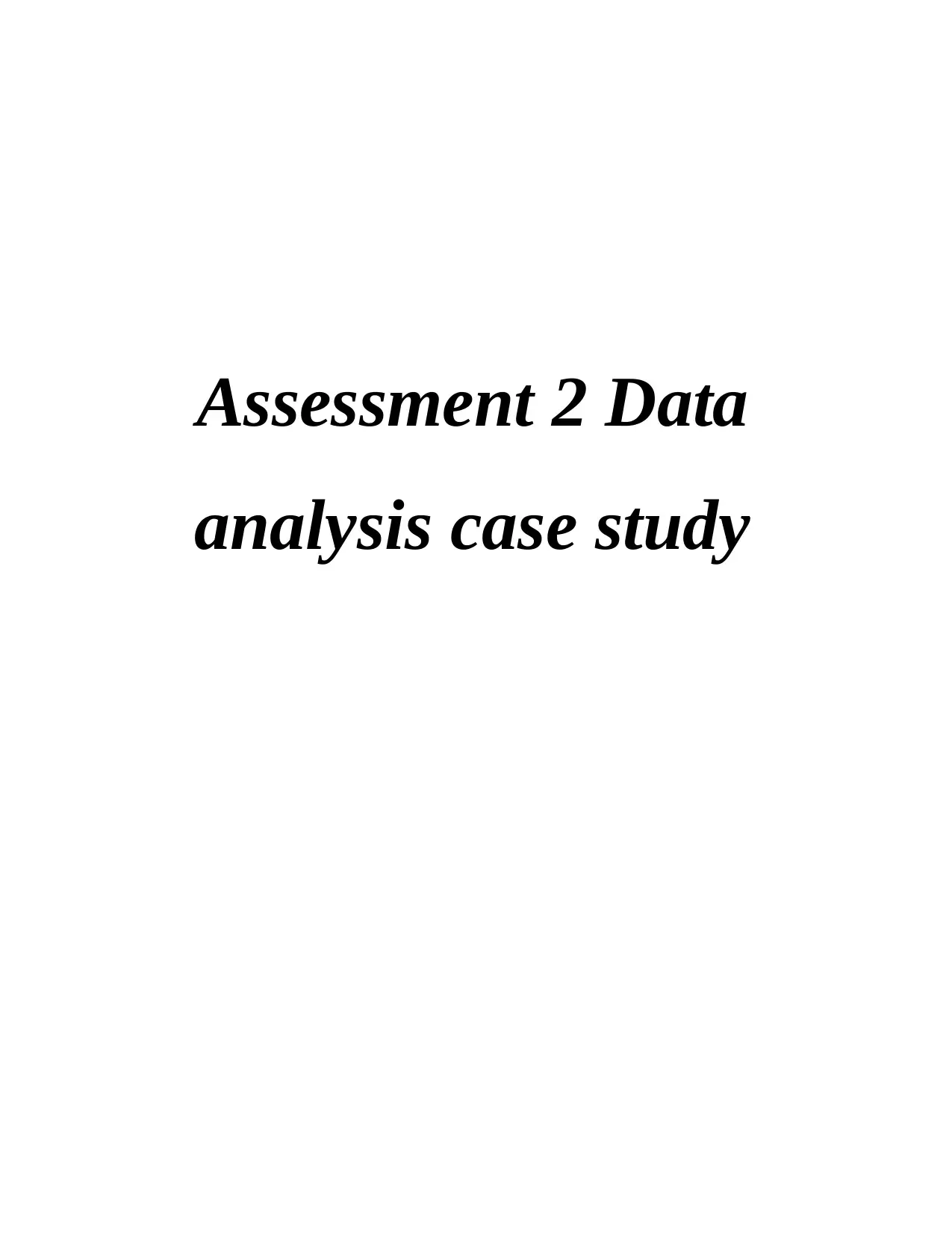
Assessment 2 Data
analysis case study
analysis case study
Secure Best Marks with AI Grader
Need help grading? Try our AI Grader for instant feedback on your assignments.
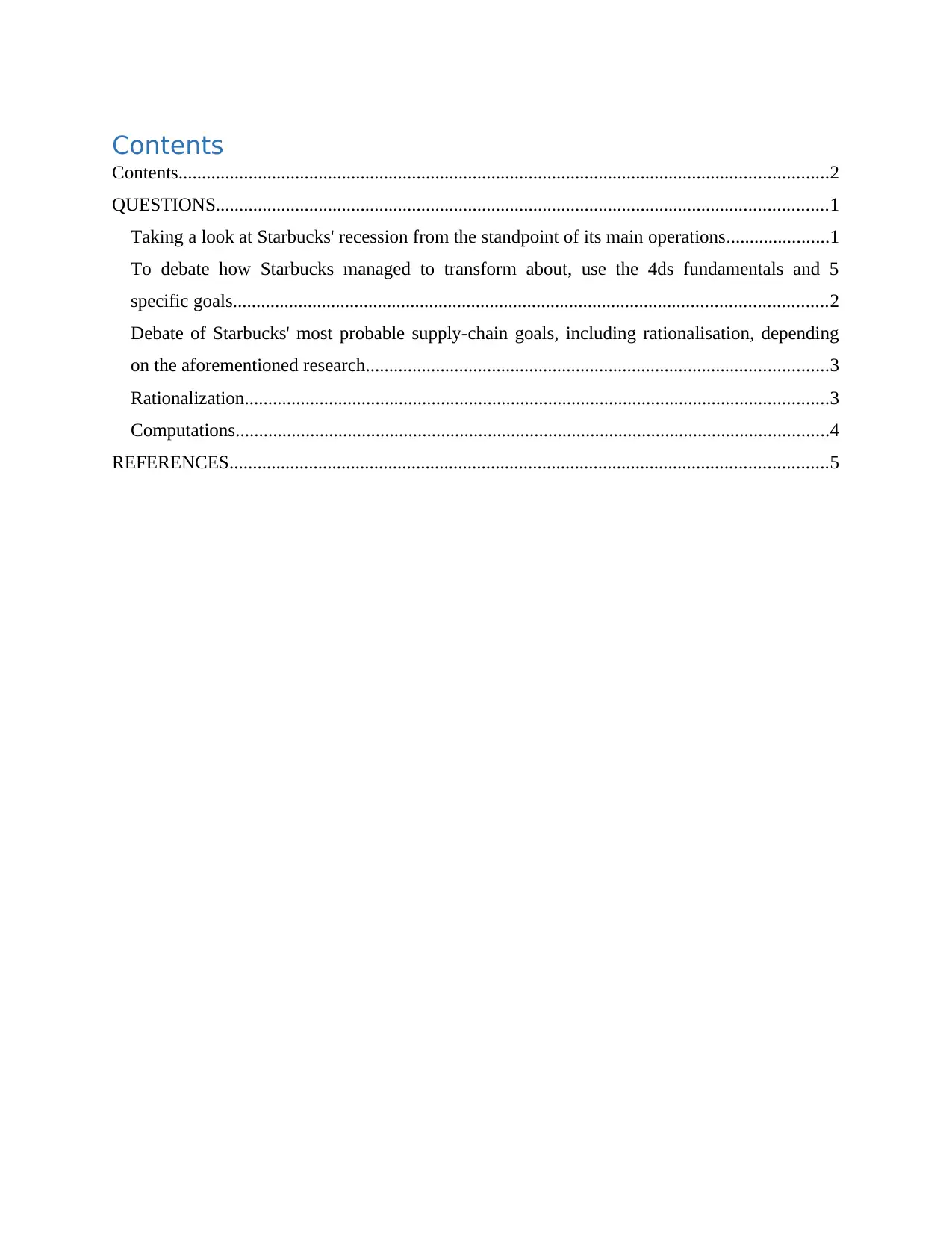
Contents
Contents...........................................................................................................................................2
QUESTIONS...................................................................................................................................1
Taking a look at Starbucks' recession from the standpoint of its main operations......................1
To debate how Starbucks managed to transform about, use the 4ds fundamentals and 5
specific goals...............................................................................................................................2
Debate of Starbucks' most probable supply-chain goals, including rationalisation, depending
on the aforementioned research...................................................................................................3
Rationalization.............................................................................................................................3
Computations...............................................................................................................................4
REFERENCES................................................................................................................................5
Contents...........................................................................................................................................2
QUESTIONS...................................................................................................................................1
Taking a look at Starbucks' recession from the standpoint of its main operations......................1
To debate how Starbucks managed to transform about, use the 4ds fundamentals and 5
specific goals...............................................................................................................................2
Debate of Starbucks' most probable supply-chain goals, including rationalisation, depending
on the aforementioned research...................................................................................................3
Rationalization.............................................................................................................................3
Computations...............................................................................................................................4
REFERENCES................................................................................................................................5
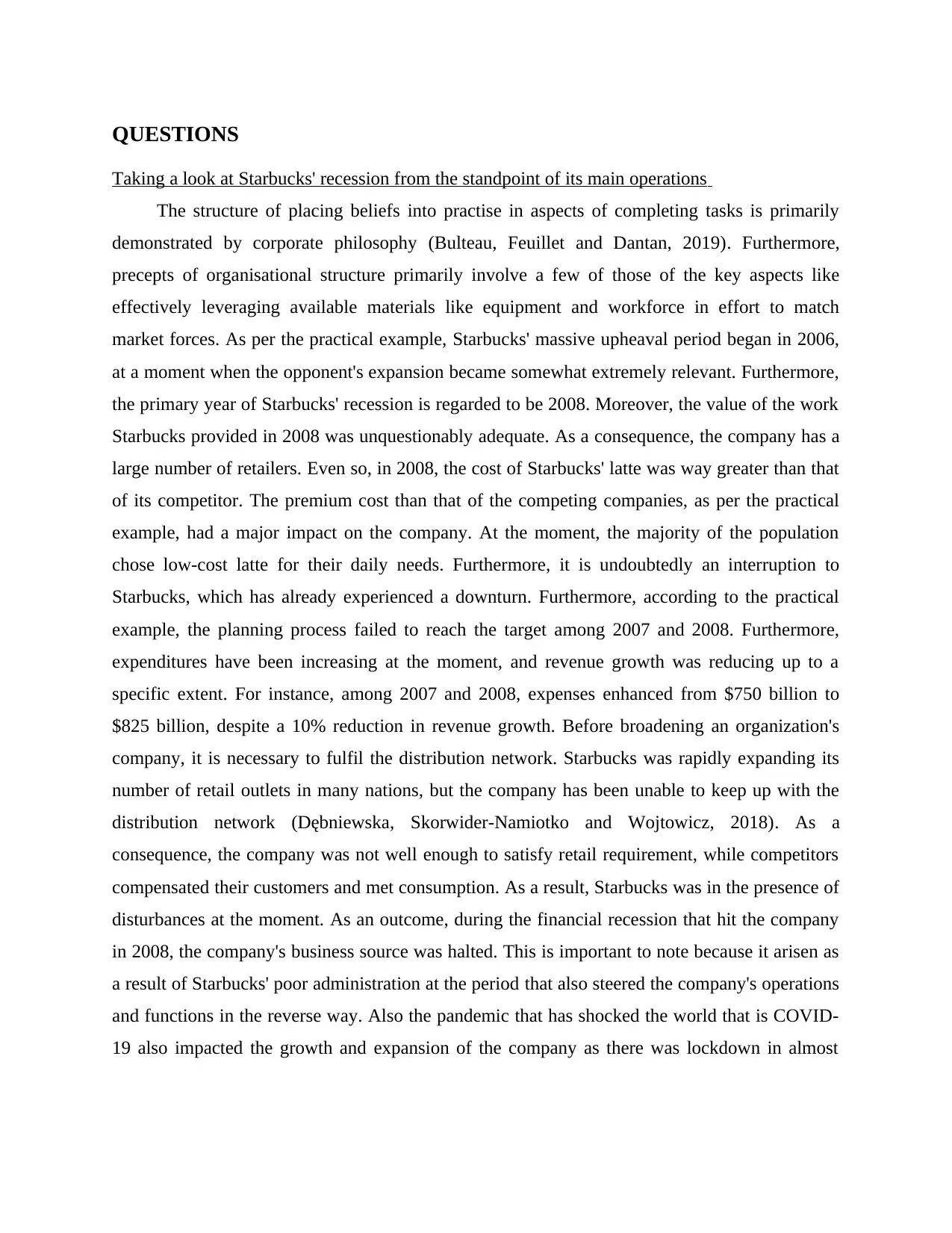
QUESTIONS
Taking a look at Starbucks' recession from the standpoint of its main operations
The structure of placing beliefs into practise in aspects of completing tasks is primarily
demonstrated by corporate philosophy (Bulteau, Feuillet and Dantan, 2019). Furthermore,
precepts of organisational structure primarily involve a few of those of the key aspects like
effectively leveraging available materials like equipment and workforce in effort to match
market forces. As per the practical example, Starbucks' massive upheaval period began in 2006,
at a moment when the opponent's expansion became somewhat extremely relevant. Furthermore,
the primary year of Starbucks' recession is regarded to be 2008. Moreover, the value of the work
Starbucks provided in 2008 was unquestionably adequate. As a consequence, the company has a
large number of retailers. Even so, in 2008, the cost of Starbucks' latte was way greater than that
of its competitor. The premium cost than that of the competing companies, as per the practical
example, had a major impact on the company. At the moment, the majority of the population
chose low-cost latte for their daily needs. Furthermore, it is undoubtedly an interruption to
Starbucks, which has already experienced a downturn. Furthermore, according to the practical
example, the planning process failed to reach the target among 2007 and 2008. Furthermore,
expenditures have been increasing at the moment, and revenue growth was reducing up to a
specific extent. For instance, among 2007 and 2008, expenses enhanced from $750 billion to
$825 billion, despite a 10% reduction in revenue growth. Before broadening an organization's
company, it is necessary to fulfil the distribution network. Starbucks was rapidly expanding its
number of retail outlets in many nations, but the company has been unable to keep up with the
distribution network (Dębniewska, Skorwider-Namiotko and Wojtowicz, 2018). As a
consequence, the company was not well enough to satisfy retail requirement, while competitors
compensated their customers and met consumption. As a result, Starbucks was in the presence of
disturbances at the moment. As an outcome, during the financial recession that hit the company
in 2008, the company's business source was halted. This is important to note because it arisen as
a result of Starbucks' poor administration at the period that also steered the company's operations
and functions in the reverse way. Also the pandemic that has shocked the world that is COVID-
19 also impacted the growth and expansion of the company as there was lockdown in almost
Taking a look at Starbucks' recession from the standpoint of its main operations
The structure of placing beliefs into practise in aspects of completing tasks is primarily
demonstrated by corporate philosophy (Bulteau, Feuillet and Dantan, 2019). Furthermore,
precepts of organisational structure primarily involve a few of those of the key aspects like
effectively leveraging available materials like equipment and workforce in effort to match
market forces. As per the practical example, Starbucks' massive upheaval period began in 2006,
at a moment when the opponent's expansion became somewhat extremely relevant. Furthermore,
the primary year of Starbucks' recession is regarded to be 2008. Moreover, the value of the work
Starbucks provided in 2008 was unquestionably adequate. As a consequence, the company has a
large number of retailers. Even so, in 2008, the cost of Starbucks' latte was way greater than that
of its competitor. The premium cost than that of the competing companies, as per the practical
example, had a major impact on the company. At the moment, the majority of the population
chose low-cost latte for their daily needs. Furthermore, it is undoubtedly an interruption to
Starbucks, which has already experienced a downturn. Furthermore, according to the practical
example, the planning process failed to reach the target among 2007 and 2008. Furthermore,
expenditures have been increasing at the moment, and revenue growth was reducing up to a
specific extent. For instance, among 2007 and 2008, expenses enhanced from $750 billion to
$825 billion, despite a 10% reduction in revenue growth. Before broadening an organization's
company, it is necessary to fulfil the distribution network. Starbucks was rapidly expanding its
number of retail outlets in many nations, but the company has been unable to keep up with the
distribution network (Dębniewska, Skorwider-Namiotko and Wojtowicz, 2018). As a
consequence, the company was not well enough to satisfy retail requirement, while competitors
compensated their customers and met consumption. As a result, Starbucks was in the presence of
disturbances at the moment. As an outcome, during the financial recession that hit the company
in 2008, the company's business source was halted. This is important to note because it arisen as
a result of Starbucks' poor administration at the period that also steered the company's operations
and functions in the reverse way. Also the pandemic that has shocked the world that is COVID-
19 also impacted the growth and expansion of the company as there was lockdown in almost
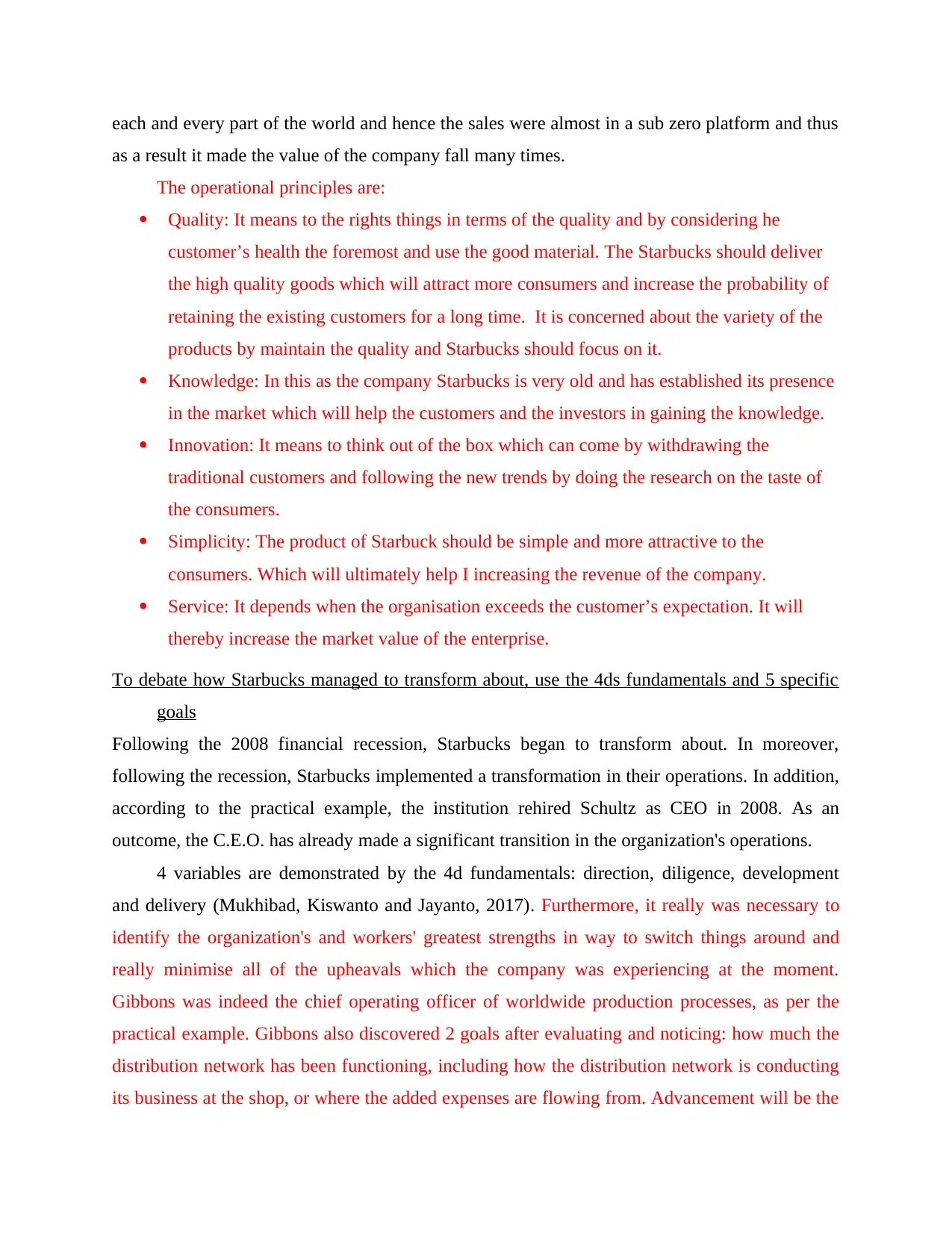
each and every part of the world and hence the sales were almost in a sub zero platform and thus
as a result it made the value of the company fall many times.
The operational principles are:
Quality: It means to the rights things in terms of the quality and by considering he
customer’s health the foremost and use the good material. The Starbucks should deliver
the high quality goods which will attract more consumers and increase the probability of
retaining the existing customers for a long time. It is concerned about the variety of the
products by maintain the quality and Starbucks should focus on it.
Knowledge: In this as the company Starbucks is very old and has established its presence
in the market which will help the customers and the investors in gaining the knowledge.
Innovation: It means to think out of the box which can come by withdrawing the
traditional customers and following the new trends by doing the research on the taste of
the consumers.
Simplicity: The product of Starbuck should be simple and more attractive to the
consumers. Which will ultimately help I increasing the revenue of the company.
Service: It depends when the organisation exceeds the customer’s expectation. It will
thereby increase the market value of the enterprise.
To debate how Starbucks managed to transform about, use the 4ds fundamentals and 5 specific
goals
Following the 2008 financial recession, Starbucks began to transform about. In moreover,
following the recession, Starbucks implemented a transformation in their operations. In addition,
according to the practical example, the institution rehired Schultz as CEO in 2008. As an
outcome, the C.E.O. has already made a significant transition in the organization's operations.
4 variables are demonstrated by the 4d fundamentals: direction, diligence, development
and delivery (Mukhibad, Kiswanto and Jayanto, 2017). Furthermore, it really was necessary to
identify the organization's and workers' greatest strengths in way to switch things around and
really minimise all of the upheavals which the company was experiencing at the moment.
Gibbons was indeed the chief operating officer of worldwide production processes, as per the
practical example. Gibbons also discovered 2 goals after evaluating and noticing: how much the
distribution network has been functioning, including how the distribution network is conducting
its business at the shop, or where the added expenses are flowing from. Advancement will be the
as a result it made the value of the company fall many times.
The operational principles are:
Quality: It means to the rights things in terms of the quality and by considering he
customer’s health the foremost and use the good material. The Starbucks should deliver
the high quality goods which will attract more consumers and increase the probability of
retaining the existing customers for a long time. It is concerned about the variety of the
products by maintain the quality and Starbucks should focus on it.
Knowledge: In this as the company Starbucks is very old and has established its presence
in the market which will help the customers and the investors in gaining the knowledge.
Innovation: It means to think out of the box which can come by withdrawing the
traditional customers and following the new trends by doing the research on the taste of
the consumers.
Simplicity: The product of Starbuck should be simple and more attractive to the
consumers. Which will ultimately help I increasing the revenue of the company.
Service: It depends when the organisation exceeds the customer’s expectation. It will
thereby increase the market value of the enterprise.
To debate how Starbucks managed to transform about, use the 4ds fundamentals and 5 specific
goals
Following the 2008 financial recession, Starbucks began to transform about. In moreover,
following the recession, Starbucks implemented a transformation in their operations. In addition,
according to the practical example, the institution rehired Schultz as CEO in 2008. As an
outcome, the C.E.O. has already made a significant transition in the organization's operations.
4 variables are demonstrated by the 4d fundamentals: direction, diligence, development
and delivery (Mukhibad, Kiswanto and Jayanto, 2017). Furthermore, it really was necessary to
identify the organization's and workers' greatest strengths in way to switch things around and
really minimise all of the upheavals which the company was experiencing at the moment.
Gibbons was indeed the chief operating officer of worldwide production processes, as per the
practical example. Gibbons also discovered 2 goals after evaluating and noticing: how much the
distribution network has been functioning, including how the distribution network is conducting
its business at the shop, or where the added expenses are flowing from. Advancement will be the
Secure Best Marks with AI Grader
Need help grading? Try our AI Grader for instant feedback on your assignments.
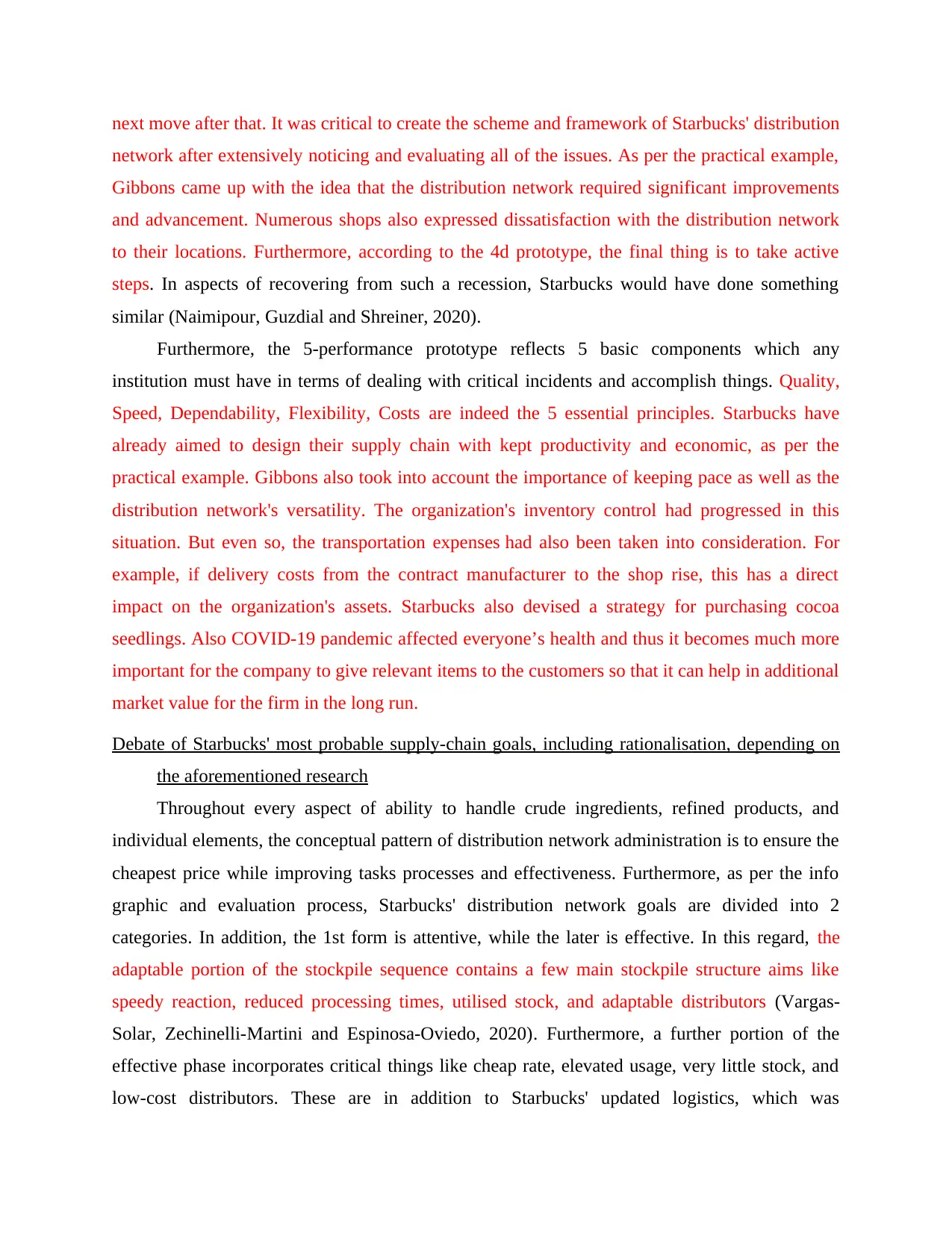
next move after that. It was critical to create the scheme and framework of Starbucks' distribution
network after extensively noticing and evaluating all of the issues. As per the practical example,
Gibbons came up with the idea that the distribution network required significant improvements
and advancement. Numerous shops also expressed dissatisfaction with the distribution network
to their locations. Furthermore, according to the 4d prototype, the final thing is to take active
steps. In aspects of recovering from such a recession, Starbucks would have done something
similar (Naimipour, Guzdial and Shreiner, 2020).
Furthermore, the 5-performance prototype reflects 5 basic components which any
institution must have in terms of dealing with critical incidents and accomplish things. Quality,
Speed, Dependability, Flexibility, Costs are indeed the 5 essential principles. Starbucks have
already aimed to design their supply chain with kept productivity and economic, as per the
practical example. Gibbons also took into account the importance of keeping pace as well as the
distribution network's versatility. The organization's inventory control had progressed in this
situation. But even so, the transportation expenses had also been taken into consideration. For
example, if delivery costs from the contract manufacturer to the shop rise, this has a direct
impact on the organization's assets. Starbucks also devised a strategy for purchasing cocoa
seedlings. Also COVID-19 pandemic affected everyone’s health and thus it becomes much more
important for the company to give relevant items to the customers so that it can help in additional
market value for the firm in the long run.
Debate of Starbucks' most probable supply-chain goals, including rationalisation, depending on
the aforementioned research
Throughout every aspect of ability to handle crude ingredients, refined products, and
individual elements, the conceptual pattern of distribution network administration is to ensure the
cheapest price while improving tasks processes and effectiveness. Furthermore, as per the info
graphic and evaluation process, Starbucks' distribution network goals are divided into 2
categories. In addition, the 1st form is attentive, while the later is effective. In this regard, the
adaptable portion of the stockpile sequence contains a few main stockpile structure aims like
speedy reaction, reduced processing times, utilised stock, and adaptable distributors (Vargas-
Solar, Zechinelli-Martini and Espinosa-Oviedo, 2020). Furthermore, a further portion of the
effective phase incorporates critical things like cheap rate, elevated usage, very little stock, and
low-cost distributors. These are in addition to Starbucks' updated logistics, which was
network after extensively noticing and evaluating all of the issues. As per the practical example,
Gibbons came up with the idea that the distribution network required significant improvements
and advancement. Numerous shops also expressed dissatisfaction with the distribution network
to their locations. Furthermore, according to the 4d prototype, the final thing is to take active
steps. In aspects of recovering from such a recession, Starbucks would have done something
similar (Naimipour, Guzdial and Shreiner, 2020).
Furthermore, the 5-performance prototype reflects 5 basic components which any
institution must have in terms of dealing with critical incidents and accomplish things. Quality,
Speed, Dependability, Flexibility, Costs are indeed the 5 essential principles. Starbucks have
already aimed to design their supply chain with kept productivity and economic, as per the
practical example. Gibbons also took into account the importance of keeping pace as well as the
distribution network's versatility. The organization's inventory control had progressed in this
situation. But even so, the transportation expenses had also been taken into consideration. For
example, if delivery costs from the contract manufacturer to the shop rise, this has a direct
impact on the organization's assets. Starbucks also devised a strategy for purchasing cocoa
seedlings. Also COVID-19 pandemic affected everyone’s health and thus it becomes much more
important for the company to give relevant items to the customers so that it can help in additional
market value for the firm in the long run.
Debate of Starbucks' most probable supply-chain goals, including rationalisation, depending on
the aforementioned research
Throughout every aspect of ability to handle crude ingredients, refined products, and
individual elements, the conceptual pattern of distribution network administration is to ensure the
cheapest price while improving tasks processes and effectiveness. Furthermore, as per the info
graphic and evaluation process, Starbucks' distribution network goals are divided into 2
categories. In addition, the 1st form is attentive, while the later is effective. In this regard, the
adaptable portion of the stockpile sequence contains a few main stockpile structure aims like
speedy reaction, reduced processing times, utilised stock, and adaptable distributors (Vargas-
Solar, Zechinelli-Martini and Espinosa-Oviedo, 2020). Furthermore, a further portion of the
effective phase incorporates critical things like cheap rate, elevated usage, very little stock, and
low-cost distributors. These are in addition to Starbucks' updated logistics, which was
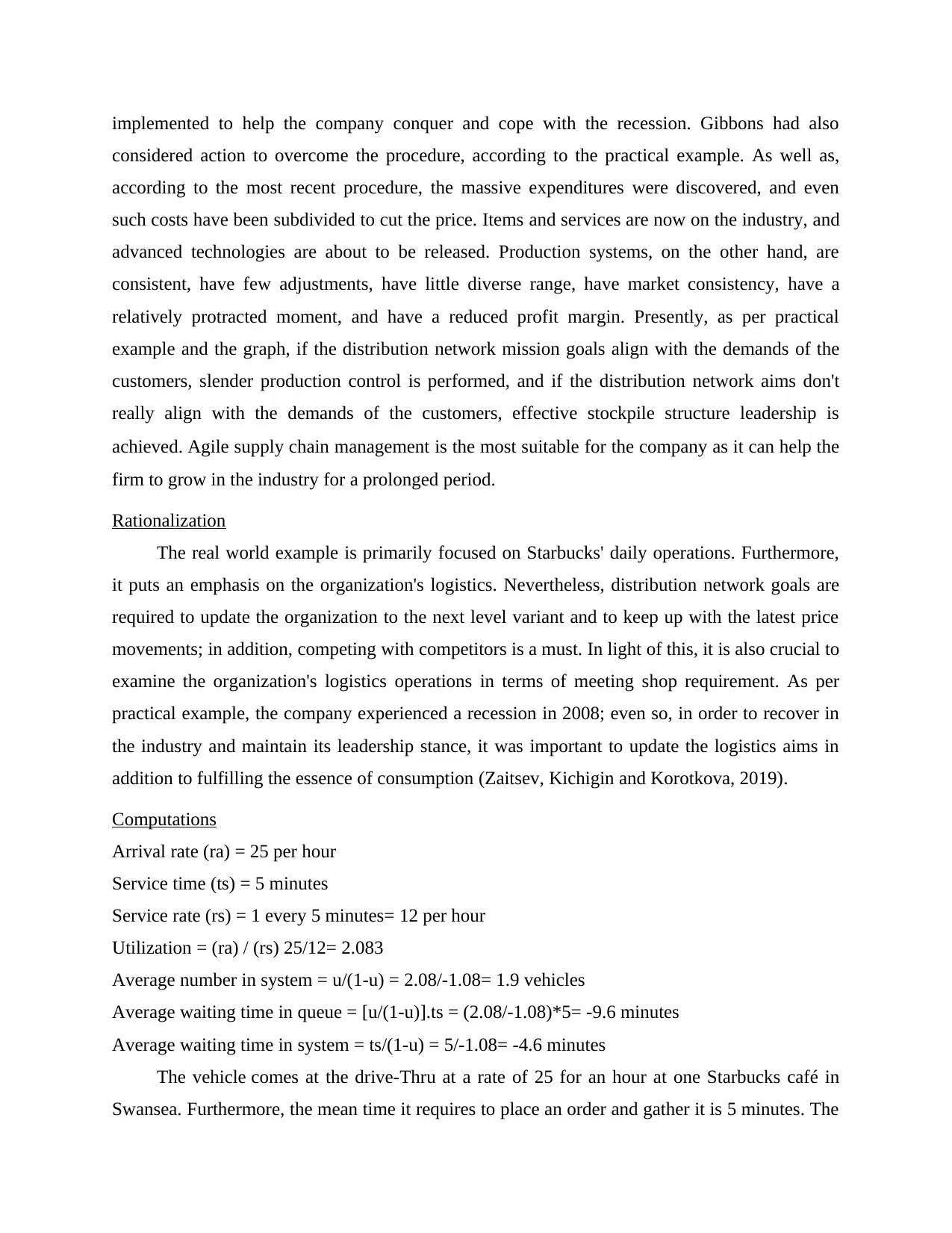
implemented to help the company conquer and cope with the recession. Gibbons had also
considered action to overcome the procedure, according to the practical example. As well as,
according to the most recent procedure, the massive expenditures were discovered, and even
such costs have been subdivided to cut the price. Items and services are now on the industry, and
advanced technologies are about to be released. Production systems, on the other hand, are
consistent, have few adjustments, have little diverse range, have market consistency, have a
relatively protracted moment, and have a reduced profit margin. Presently, as per practical
example and the graph, if the distribution network mission goals align with the demands of the
customers, slender production control is performed, and if the distribution network aims don't
really align with the demands of the customers, effective stockpile structure leadership is
achieved. Agile supply chain management is the most suitable for the company as it can help the
firm to grow in the industry for a prolonged period.
Rationalization
The real world example is primarily focused on Starbucks' daily operations. Furthermore,
it puts an emphasis on the organization's logistics. Nevertheless, distribution network goals are
required to update the organization to the next level variant and to keep up with the latest price
movements; in addition, competing with competitors is a must. In light of this, it is also crucial to
examine the organization's logistics operations in terms of meeting shop requirement. As per
practical example, the company experienced a recession in 2008; even so, in order to recover in
the industry and maintain its leadership stance, it was important to update the logistics aims in
addition to fulfilling the essence of consumption (Zaitsev, Kichigin and Korotkova, 2019).
Computations
Arrival rate (ra) = 25 per hour
Service time (ts) = 5 minutes
Service rate (rs) = 1 every 5 minutes= 12 per hour
Utilization = (ra) / (rs) 25/12= 2.083
Average number in system = u/(1-u) = 2.08/-1.08= 1.9 vehicles
Average waiting time in queue = [u/(1-u)].ts = (2.08/-1.08)*5= -9.6 minutes
Average waiting time in system = ts/(1-u) = 5/-1.08= -4.6 minutes
The vehicle comes at the drive-Thru at a rate of 25 for an hour at one Starbucks café in
Swansea. Furthermore, the mean time it requires to place an order and gather it is 5 minutes. The
considered action to overcome the procedure, according to the practical example. As well as,
according to the most recent procedure, the massive expenditures were discovered, and even
such costs have been subdivided to cut the price. Items and services are now on the industry, and
advanced technologies are about to be released. Production systems, on the other hand, are
consistent, have few adjustments, have little diverse range, have market consistency, have a
relatively protracted moment, and have a reduced profit margin. Presently, as per practical
example and the graph, if the distribution network mission goals align with the demands of the
customers, slender production control is performed, and if the distribution network aims don't
really align with the demands of the customers, effective stockpile structure leadership is
achieved. Agile supply chain management is the most suitable for the company as it can help the
firm to grow in the industry for a prolonged period.
Rationalization
The real world example is primarily focused on Starbucks' daily operations. Furthermore,
it puts an emphasis on the organization's logistics. Nevertheless, distribution network goals are
required to update the organization to the next level variant and to keep up with the latest price
movements; in addition, competing with competitors is a must. In light of this, it is also crucial to
examine the organization's logistics operations in terms of meeting shop requirement. As per
practical example, the company experienced a recession in 2008; even so, in order to recover in
the industry and maintain its leadership stance, it was important to update the logistics aims in
addition to fulfilling the essence of consumption (Zaitsev, Kichigin and Korotkova, 2019).
Computations
Arrival rate (ra) = 25 per hour
Service time (ts) = 5 minutes
Service rate (rs) = 1 every 5 minutes= 12 per hour
Utilization = (ra) / (rs) 25/12= 2.083
Average number in system = u/(1-u) = 2.08/-1.08= 1.9 vehicles
Average waiting time in queue = [u/(1-u)].ts = (2.08/-1.08)*5= -9.6 minutes
Average waiting time in system = ts/(1-u) = 5/-1.08= -4.6 minutes
The vehicle comes at the drive-Thru at a rate of 25 for an hour at one Starbucks café in
Swansea. Furthermore, the mean time it requires to place an order and gather it is 5 minutes. The
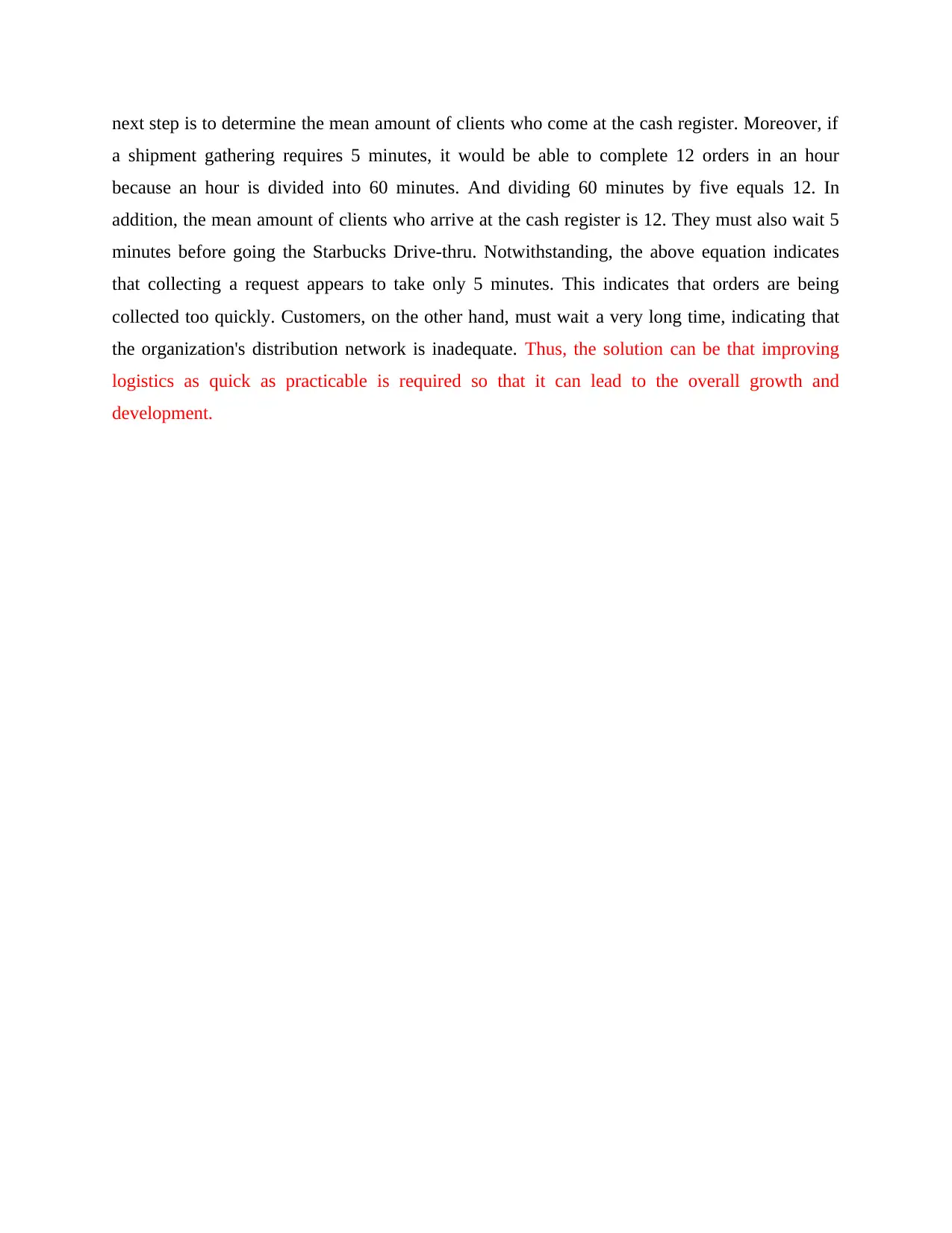
next step is to determine the mean amount of clients who come at the cash register. Moreover, if
a shipment gathering requires 5 minutes, it would be able to complete 12 orders in an hour
because an hour is divided into 60 minutes. And dividing 60 minutes by five equals 12. In
addition, the mean amount of clients who arrive at the cash register is 12. They must also wait 5
minutes before going the Starbucks Drive-thru. Notwithstanding, the above equation indicates
that collecting a request appears to take only 5 minutes. This indicates that orders are being
collected too quickly. Customers, on the other hand, must wait a very long time, indicating that
the organization's distribution network is inadequate. Thus, the solution can be that improving
logistics as quick as practicable is required so that it can lead to the overall growth and
development.
a shipment gathering requires 5 minutes, it would be able to complete 12 orders in an hour
because an hour is divided into 60 minutes. And dividing 60 minutes by five equals 12. In
addition, the mean amount of clients who arrive at the cash register is 12. They must also wait 5
minutes before going the Starbucks Drive-thru. Notwithstanding, the above equation indicates
that collecting a request appears to take only 5 minutes. This indicates that orders are being
collected too quickly. Customers, on the other hand, must wait a very long time, indicating that
the organization's distribution network is inadequate. Thus, the solution can be that improving
logistics as quick as practicable is required so that it can lead to the overall growth and
development.
Paraphrase This Document
Need a fresh take? Get an instant paraphrase of this document with our AI Paraphraser
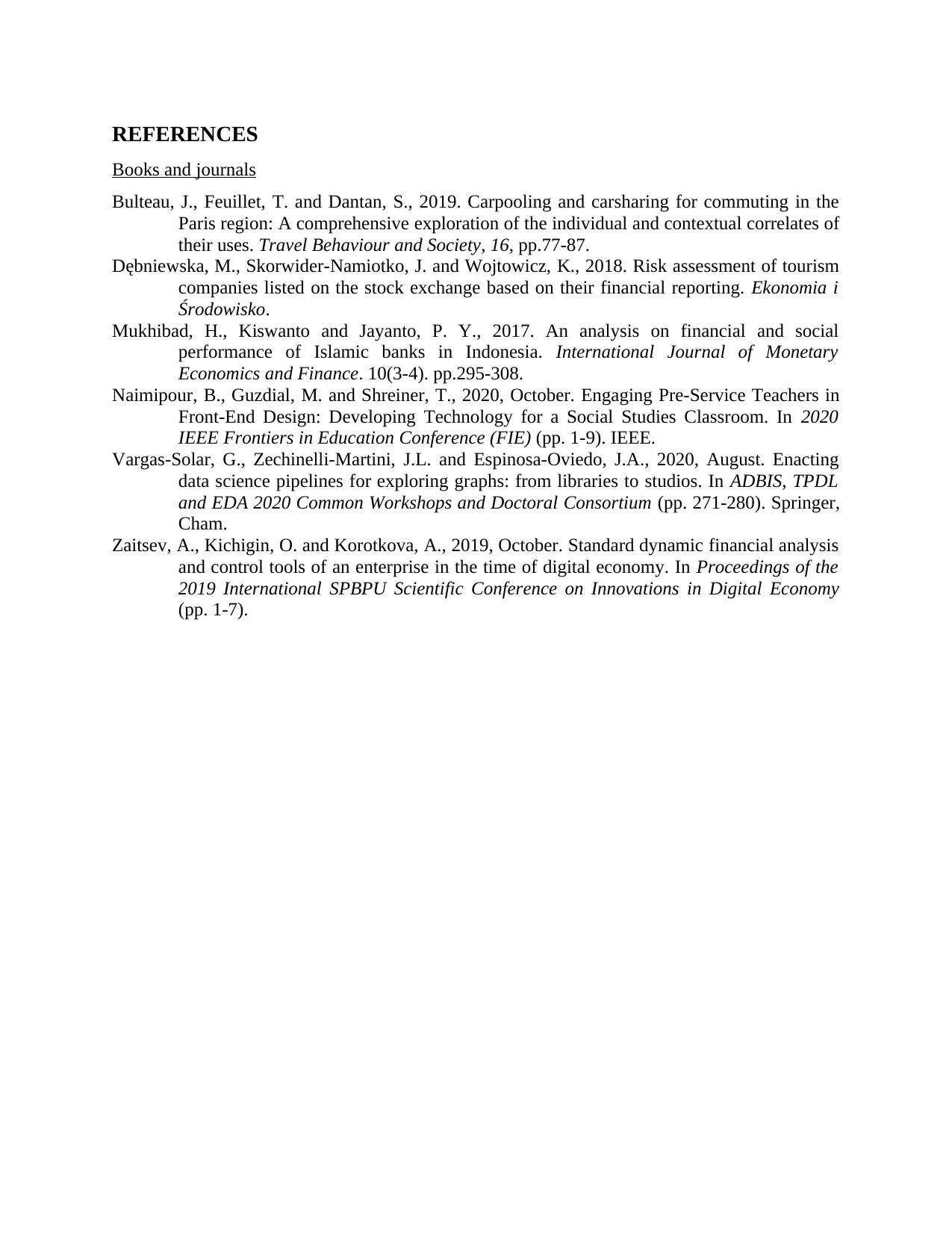
REFERENCES
Books and journals
Bulteau, J., Feuillet, T. and Dantan, S., 2019. Carpooling and carsharing for commuting in the
Paris region: A comprehensive exploration of the individual and contextual correlates of
their uses. Travel Behaviour and Society, 16, pp.77-87.
Dębniewska, M., Skorwider-Namiotko, J. and Wojtowicz, K., 2018. Risk assessment of tourism
companies listed on the stock exchange based on their financial reporting. Ekonomia i
Środowisko.
Mukhibad, H., Kiswanto and Jayanto, P. Y., 2017. An analysis on financial and social
performance of Islamic banks in Indonesia. International Journal of Monetary
Economics and Finance. 10(3-4). pp.295-308.
Naimipour, B., Guzdial, M. and Shreiner, T., 2020, October. Engaging Pre-Service Teachers in
Front-End Design: Developing Technology for a Social Studies Classroom. In 2020
IEEE Frontiers in Education Conference (FIE) (pp. 1-9). IEEE.
Vargas-Solar, G., Zechinelli-Martini, J.L. and Espinosa-Oviedo, J.A., 2020, August. Enacting
data science pipelines for exploring graphs: from libraries to studios. In ADBIS, TPDL
and EDA 2020 Common Workshops and Doctoral Consortium (pp. 271-280). Springer,
Cham.
Zaitsev, A., Kichigin, O. and Korotkova, A., 2019, October. Standard dynamic financial analysis
and control tools of an enterprise in the time of digital economy. In Proceedings of the
2019 International SPBPU Scientific Conference on Innovations in Digital Economy
(pp. 1-7).
Books and journals
Bulteau, J., Feuillet, T. and Dantan, S., 2019. Carpooling and carsharing for commuting in the
Paris region: A comprehensive exploration of the individual and contextual correlates of
their uses. Travel Behaviour and Society, 16, pp.77-87.
Dębniewska, M., Skorwider-Namiotko, J. and Wojtowicz, K., 2018. Risk assessment of tourism
companies listed on the stock exchange based on their financial reporting. Ekonomia i
Środowisko.
Mukhibad, H., Kiswanto and Jayanto, P. Y., 2017. An analysis on financial and social
performance of Islamic banks in Indonesia. International Journal of Monetary
Economics and Finance. 10(3-4). pp.295-308.
Naimipour, B., Guzdial, M. and Shreiner, T., 2020, October. Engaging Pre-Service Teachers in
Front-End Design: Developing Technology for a Social Studies Classroom. In 2020
IEEE Frontiers in Education Conference (FIE) (pp. 1-9). IEEE.
Vargas-Solar, G., Zechinelli-Martini, J.L. and Espinosa-Oviedo, J.A., 2020, August. Enacting
data science pipelines for exploring graphs: from libraries to studios. In ADBIS, TPDL
and EDA 2020 Common Workshops and Doctoral Consortium (pp. 271-280). Springer,
Cham.
Zaitsev, A., Kichigin, O. and Korotkova, A., 2019, October. Standard dynamic financial analysis
and control tools of an enterprise in the time of digital economy. In Proceedings of the
2019 International SPBPU Scientific Conference on Innovations in Digital Economy
(pp. 1-7).
1 out of 8
Related Documents
Your All-in-One AI-Powered Toolkit for Academic Success.
+13062052269
info@desklib.com
Available 24*7 on WhatsApp / Email
![[object Object]](/_next/static/media/star-bottom.7253800d.svg)
Unlock your academic potential
© 2024 | Zucol Services PVT LTD | All rights reserved.



